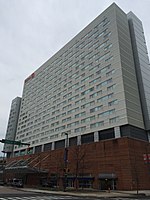Baltimore railroad strike of 1877

The Baltimore railroad strike of 1877 involved several days of work stoppage and violence in Baltimore, Maryland, in 1877. It formed a part of the Great Railroad Strike of 1877, during which widespread civil unrest spread nationwide following the global depression and economic downturns of the mid-1870s. Strikes broke out along the Baltimore and Ohio Railroad (B&O) on July 16, the same day that 10% wage reductions were scheduled. Violence erupted in Baltimore on July 20, with police and soldiers of the Maryland National Guard clashing with crowds of thousands gathered throughout the city. In response, President Rutherford B. Hayes ordered federal troops to Baltimore, local officials recruited 500 additional police, and two new national guard regiments were formed. Peace was restored on July 22. Between 10 and 22 were killed, more than 150 were injured, and many more were arrested. Negotiations between strikers and the B&O were unsuccessful, and most strikers quit rather than return to work at the newly reduced wages. The company easily found enough workers to replace the strikers, and under the protection of the military and police, traffic resumed on July 29. The company promised minor concessions at the time, and eventually enacted select reforms later that year.
Excerpt from the Wikipedia article Baltimore railroad strike of 1877 (License: CC BY-SA 3.0, Authors, Images).Baltimore railroad strike of 1877
Cal Ripken Way, Baltimore
Geographical coordinates (GPS) Address Nearby Places Show on map
Geographical coordinates (GPS)
| Latitude | Longitude |
|---|---|
| N 39.28346 ° | E -76.619554 ° |
Address
Camden Yards
Cal Ripken Way
21230 Baltimore
Maryland, United States
Open on Google Maps










